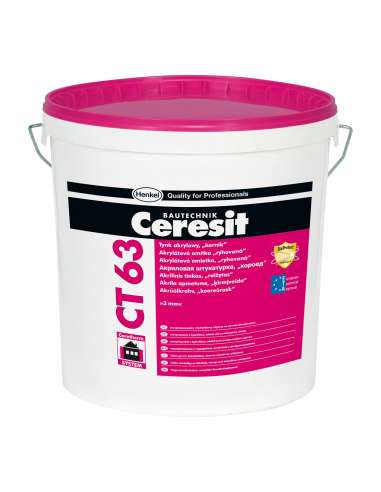- Manufactured in more than one hundred sixty colours
- Ready to use
- Vapour permeable
- Hydrophobic
- Resistant to weather conditions
- Amount required: approx. 3.7 kg/m2
CT 63 is suitable for application on traditional plasters, concrete, gypsum substrates, woodchip, gypsum boards, etc. It conveys a “rustic” texture upon floating. It isuitable for indoor and outdoor use.
CT 63 adheres to all solid, load-bearing, clean and dry substrates free of substances which may impair adhesion. Test the surface for load-bearing strength. Level out any unevenness before plastering. Completely remove non-bearing dispersion paint coats, elastic coatings, distempers, lining paper, wallpaper paste, hydraulic binder paints or the like. Use CT 16 to prime firmly adhering paintwork as well as new lime or cement plasters (mortar groups PII, PIII; at least 28 days old) and gypsum plasterboards. Heat insulating plasters are not suited for coating. Gypsum plasters (at least 28 days old), plasterboards, plywood and wood chipboards (V 100, minimum thickness 19 mm) must be primed with CT 17 and, when dry, painted with CT 16. On bleeding ingredients use a commercial insulating varnish instead of CT 17. Old lime and cement plasters (more than 1 year old), concrete and fibrous cement boards must be primed with CT 17 (indoors) or CT 14 (outdoors); after drying apply CT 16. Aerated concrete and lightweight concrete elements must be painted twice with CT 16. Always use a brush to apply the appropriate priming coat. Plaster cracks and structural cracks require special treatment. Where necessary, repair cracks with CT 92 and CT 93.
After the priming coat has dried, apply CT 63 using the screeding technique. Stir the plaster thoroughly before application. If necessary, carefully add water (very small amounts, max. 200 ml on 30 kg) until the desired consistency is achieved. Apply the plaster with a stainless steel trowel and, with the trowel held at an angle, lift the plaster off so that the coarse granulate shows at the surface. Texture the finishing coat with a plastic float or plastic trowel within the open time. Depending on the desired texture, the plaster can be worked horizontally, vertically, circularly or diagonally. Do not interrupt work when plastering a large surface. When working from several scaffolding levels, apply the plaster simultaneously wet-in-wet to avoid edging. Adhesive tape must be removed before start of skin formation. Repeatedly wash the tools off with water and clean them with water after use. Hardened material can only be removed with a solvent or paint remover. Final hardness is achieved after approx. 3 weeks.
- Model
- CT63
- Usage/Coverage
- grain 3mm - approx. 3.7 kg/sqm
- Size
- 25 kg
- Unit
- bucket


